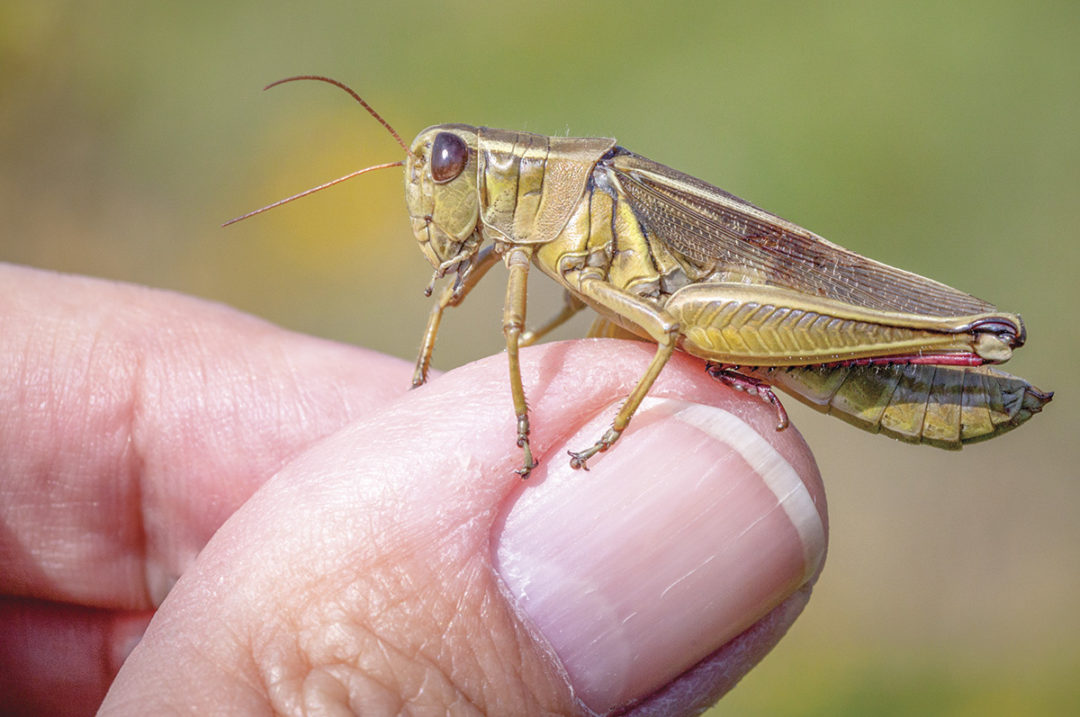It may not be time to worry, but we definitely should be on guard. Grasshopper numbers (and their cousins the Mormon crickets – actually katydids) often explode following long, dry, warm fall temperatures. Arash Rashed, University of Idaho entomologist, said the drought of last summer and fall combined with warmer temperatures throughout the fall can be a major trigger for extending the egg-laying period, thus increasing egg survivability. According to the predictive models, Rashed said, we should pay some attention and watch for the possibility of an infestation.
Grasshoppers are specifically what will be addressed in this article. Grasshopper eggs are laid in late summer and fall in the upper 2 inches of soil. They prefer undisturbed, hard soil such as is found on roadsides and in pastures or outer edges of fields. Each egg sac contains 20 to 100 eggs, with a survival rate of about 40%. The grasshoppers emerge from the egg looking like smaller versions of the adult grasshopper, with the absence of wings. Instead of going through a pupae stage, the grasshopper goes through a series of molts, where it sheds the outer layer and develops an expanded new one, eventually developing wings. This creates one generation per year in Idaho’s climate.
There are at least three species of grasshoppers that cause most of the damage in Idaho: red-legged grasshopper, two-striped grasshopper and migratory grasshopper.
As adults, the grasshoppers live for one to three months as they continue feeding on surrounding plant residue. It isn’t until late summer that grasshoppers (now adults) become really damaging to crops.

What makes this a potentially damaging year?
As climate temperatures change, Rashed said, it’s important to know how this affects grasshopper populations. While egg hatch timing varies among species, and with temperature and moisture, earlier hatches are happening every year. Generally, the two-striped grasshopper hatches mid- to late May. Migratory grasshoppers hatch late May to early June, and red-legged grasshoppers hatch throughout June. Earlier hatching (up to a month earlier) can threaten young seedlings in a field, and the adult grasshoppers can move into the crop when it matures, staying in the fields longer. Early seeded fall crops are especially vulnerable. “Usually, we think a seed treatment will help prevent this damage,” Rashed said, “but that’s not necessarily so.”
A lot of factors influence the numbers of grasshoppers present in any year, Rashed said. Variables in weather and moisture make a significant impact, so it’s not always easy to predict an outbreak. However, going into the 2022 season, this is what we know:
- Grasshoppers do not like extended cool and wet weather in spring: delayed hatching, increased mortality (eggs overwinter in the soil).
- They like warm springs and rain for a day or two.
- They like undisturbed soil (i.e., field edges, roadsides, no-tillage).
- They do not like dense plant canopies – they do like sun.
- In dry seasons, plants in uncultivated fields and unmanaged rangeland dry out, and grasshoppers move into cultivated fields to seek fresh food.
- Warmer fall temperatures maximize egg laying.
A predictive model for rangeland grasshoppers in Idaho is maintained by the USDA APHIS (Animal and Plant Health Inspection Service), based on grasshopper counts per square yard from the previous year’s data. The heat map created (see Figure 1) helps them monitor the hot spots for potential outbreaks in the following year.

While cattle can graze range grasses and leave a few inches of grass stalk for regrowth, a grasshopper snaps the grass blade at the dirt level so there is no chance for regrowth.
Suppression
Several factors determine if treatment is warranted. These factors include grasshopper densities per square yard, the pest species and its life stage, and treatment timing and options.
Treatment thresholds vary, but three to four grasshoppers per square yard in a young field needs management. Fifteen grasshoppers per square yard translates to about 100 pounds of grasshoppers per acre. Use insecticide applications only when a large number of grasshoppers are present (greater than seven per square yard within a field and greater than 12 per square yard in natural vegetation surrounding a field).
Cultural control methods can include tillage and crop rotation. However, producers on dryland farms need ground cover through winter, so “trap strips” can be useful. These strips are planted around the borders of a field set off from the main crop by a tillage pass. Some producers have found this helps keep the grasshoppers from infiltrating the main field, and traps the grasshoppers where they can be target controlled.
Rashed encouraged producers to check the natural vegetation around a field 10 days before planting, as seedlings are very susceptible to grasshoppers. While he said there is no reason to panic yet, we need to be aware of the factors that influence their populations. “Just be aware and count them,” Rashed said. The pattern indicates a problem year forming.
Cost assistance
According to the APHIS website, APHIS has authority to use four insecticides in their suppression treatment program: carbaryl, diflubenzuron, malathion and chlorantraniliprole. These can be used in cost-share treatment plans on state rangelands or providing 100% of treatment costs on federal lands. On private rangelands, APHIS covers 33% of treatment costs with the landowner responsible for the remainder. Cost shares are only available if APHIS conducts the treatments. APHIS does not have the authority to conduct grasshopper suppression treatments on private croplands. (For more information, go to APHIS) ![]()
Arash Rashed presented virtually, and his presentation was sponsored by the Idaho Wheat Commission. The YouTube link for the presentation is here: From the Field: How to effectively control grasshoppers in small grains.





